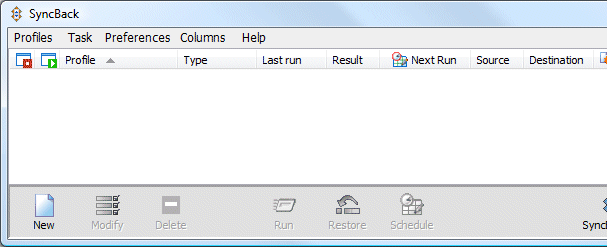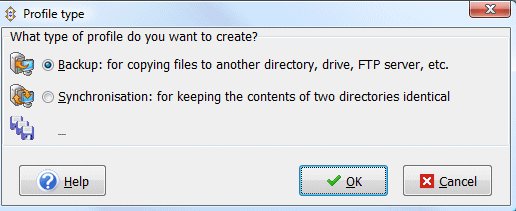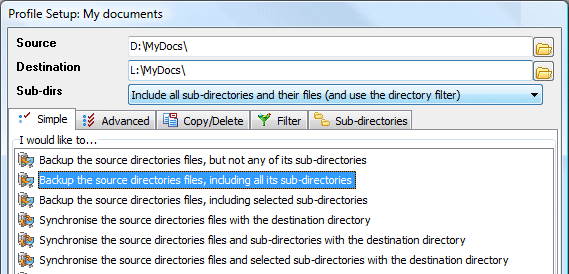
Frequently, there are users who loose their important personal data after a hard disk crash or a Windows crash and didn't create a back-up. In many cases it's still possible to recover data with a bootable CD (like Bart's PE or VistaPE) to another (external) hard disk. However, be aware that a sudden loose of power can happen anytime. This can be fatal to a hard disk, especially when it's reading or writing data at that moment. But there can be more causes of data loss. a virus which disabled the boot process, a virus which erases or overwrites data or data loss by personal interaction. Of course this doesn't happen frequently, but if you are confronted with loss of important data you wished you had a back-up...
The biggest problem for creating a back-up frequently is the lack of time. On this website there is already described where to find and how to create a back-up of the most important personal data before reinstalling Windows. The purpose of this page is to motivate readers to back-up this information frequently, especially when the data has changed considerably. Because this process takes some time over and over again, creating a back-up is postponed frequently (or even neglected) by many. But, creating a back-up can also be done automatically which saves a lot of time! Creating an automated back-up procedure can be split up in the following steps:
Which personal data are we talking about? Data which can't be recreated or replaced without any effort. Software can be reinstalled on a new computer (if still available on the net or CD). Personal data is more important. Data which you would like to have a back-up of, in case your hard disk malfunctions or your computer got stolen. In most cases it's the data stored in the folder My Documents, where almost all personal stuff is stored. To give a more complete overview, here are some locations of personal data you probably want to create a back-up of (and the default locations where you can find them):
On this website, I advise to store/move all you personal data on a special D: partition instead of integrating them on the Windows partition. This must be done for all user accounts! For more information see the page about moving the personal data to a separate partition and the page about creating a back-up of personal data, drivers and settings.
|
|
Now you know which data you would like to create a back-up of, the question rises what hardware to use. There are multiple options available:
It's very useful to automate the back-up process: it takes less time and less efford. If done properly, there is no reason anymore to 'forget' to back-up your data!
SyncBack Freeware (download: www.2brightsparks.com/downloads.html#freeware) is one of the best synchronization tools and most important: it's freeware! On the 2BrigthSparks website, you can find the download the free version of SyncBack by following the menu Downloads, Freeware (there are multiple languages available).
LET OP: 2BrightSparks has published a newer paid version of SyncBack (second edition), called SyncBackSE. Probably, the older freeware version of SyncBack will stay available for download. But you can never be sure about that. Download the setup-file and keep it on a safe location.
The setup of SyncBack is easy. There are no difficult questions to be answered. The only question you need to answer is at the first start of SyncBack. You will be asked whether you would like to create a Profile. With a profile you determine a back-up or synchronization procedure. If you rather like to wait, you can always click No (a profile can be created later on by clicking the button New). You will end up with the following screen:

By clicking the button New, you are able to create a new profile. You have to choose between two optiongs: creating a back-up or synchronization profile. In this case, creating a back-up profile is the best option.

TIP: By choosing the profile Synchronization, you are able to synchronize the data of two computers. This will result in a situation where both computers will have the newest version of each file on both computers. This feature is very useful to keep your laptop synchronized with your desktop computer. SyncBack will inform you about the changed files and even warns when both files have been changed. Especially the synchronization option of SyncBack is a very special feature which can be adjusted to any situation.
In the next screen you asked for the name of the profile you are about to create. Give the profile a name which covers the purpose of the job, for example My Documents for a profile to back-up the folder My Documents. In the following screen you are asked for the source and target location. By clicking on the yellow folder-icon on the right you can find the location easily. In the following example the source is D:\MyDocs and the target is L:\MyDocs (the back-up location on the external hard disk). The target folder didn't exist yet, by adding MyDocs manually, the folder will be created automatically the first time the profile will run.

Click OK to save the profile for creating a back-up of your My Documents folder. You are asked whether you would like to run a simulation first, which can be skipped in most cases. By selecting the profile and clicking on the button Run, the back-up procedure will start. After a while, a screen will be shown with the difference between the source (the original files) and the target (the back-up location) which have to be accepted first.
As soon as the back-up procedure has finished, you will see this in the main Window. The column Result will show the value Success, which means that the back-up procedure was able to finish the job without any problems. The column Last run shows the date and time of the last successful run.
If you would like to change the profile, you can select the profile and click Modify. This option can be useful if you would like to exclude some files and folders (tab Filter) or if you would like to have more control over the copy and deleting process (tab Advanced). Excluding less important (but continuously changing) files and folders will speed up the process.
In the next step you create a profile for each folder (with important personal data) which you would like to back-up like the Outlook or Outlook Express folder, the Windows address book, the Internet Explorer Favorites, databases which are not stored in the My Documents folder, downloads e.a. For each you can create a profile and specify the source (on the hard disk) and target folder (on the external storage location). If there is more then one user account, you probably have to create multiple profiles for each user account.
Place a reminder in your agenda to remind you to create a back-up of the personal data. This can be the last day of the week, the end of the month or just daily if you make many changes to files which you don't want to loose. If you plan to create a back-up you can start SyncBack manually. With the key-combination CTRL-A you are able to select all profiles at once. Click the button Run to start the back-up procedure. Only the changed files are copied to the back-up location which in most cases won't take much time. The only procedure you have to go through is to connect the external hard disk, start SyncBack, press CTRL-A and the button Run, confirm the suggested actions, wait and disconnect the external hard disk.
In most cases I advise to install a bigger and faster hard disk at the moment of reinstalling Windows. The advantage of installing a bigger hard disk is the overall speed improvement. The older hard disk with the important personal data can be disconnected while your data is safe during the setup of Windows. If you want to go back to the old system you can easily reconnect the old hard disk and boot in the old Windows environment.
If the Windows setup has been accomplished, you can reconnect the old hard disk as secondary hard disk (as slave next to the new one or as master by disconnecting the CD-player temporarily). With both hard disks connected, you are able to transfer the personal data to the new system with the Windows Explorer. The Windows setup will go much faster on the new hard disk, all personal data is stored safely on the old hard disk and eventually the new system will be faster then before because of the new hard disk. If the old hard disk is no longer needed, you can use an external hard disk case (which can be connected by USB, etherenet or firewire) as an external storage location for back-up purposes. With these advantages, the new harddiks becomes a valuable investment.
© 2001-2022 - Menno Schoone - SchoonePC - Rotterdam - The Netherlands